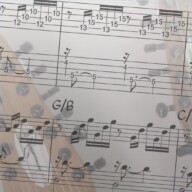Come Together (The Beatles)
4.00€
Versions:
- Instrumental + Voice
Accordage:
- Standard
- Matched Reciprocal
Audio:
- Audio mp3
Description
Come Together
The Beatles
An emblematic song by John Lennon and the opening track of the Abbey Road album, Come Together was created in 1969. Piece with mysterious lyrics, characteristic of John’s writing, it’s a kind of blues/rock. As there aren’t really any instruments that play chords but rather a tangle of guitar, electric piano and bass riffs, we can’t really know if it’s based on a Dm or a D7#9. But considering the blues side of the composition, I’ll lean more towards a D7#9 (a chord dear to Jimi Hendrix). The song is built around the famous bass riff of Paul. Riff which thanks to the tuning in fifth is rather easily realizable with the Stick. In a general way, everything that is simple in terms of fingering on an electric bass (in fourth tuning) is complicated on the Stick’s bass and vice versa. On the intro the right hand plays the riff in unison but not quite the same notes. Note for the groove of the bass riff the very fast appoggiatura from the G to the A on the second beat. The beginning of the verse is built with the same bass riff and the right hand playing a pattern of thirds in eighth notes on a kind of D Dorian. Also note that the second eighth note of the second beat is in syncope on the bass while the right hand will play the eighth note on the third beat. Set up this polyrhythm well by playing these two bars in a loop so that the two hands are well interlocked. Bar 9 further reinforces the minor or dominant ambiguity with on A7 a C flat on the bass but a F# (Am6 ?) on the melodic block. Bar 11 a new use of the ” poly-voice ” technique with the fingers hitting the strings one after the other to form a kind of held arpeggio. Re intro and second identical verse then measure 25 the descent by tones on “Come Together” with very powerful and very rocking power chords (chords without third). Measure 29 the instrumental bridge with 4 measures of electric piano riff. Note how both hands interfere. Riff in sixteenth and fourth notes in the right hand and rock bass in eighth note on D in the bass then measure 33 a 4 bars guitar fill then measure 37 over two bars the electric piano pattern that will be used throughout the coda.
Again note the interaction between the two hands, when they play together or separately. This is one of the secrets of the rhythmic setting of the Stick.
The song continues with a repetition of parts we’ve already seen, to arrive on the coda (bar 53). A rock bass in continuous eighth notes on D and the repetition of the electric piano pattern of the bridge. I’ve inserted the guitar fills that sound an octave below the original but which allows to link the two parts. Note the rhythmic puzzle of the vocal part (on the second beat) of the right hand riff and the left hand pattern. Despite their apparent complexity, all the parts fit rather well together.
Here you are at the end. Bravo !
Come Together is one of the Beatles’ songs that allows most easily a personal interpretation, surely due to its modal side. You can very well integrate a solo on a blues minor, a blues major, a modal improvisation on D minor or D7#9 (D altered). It’s up to you.














Avis
Il n’y a pas encore d’avis.